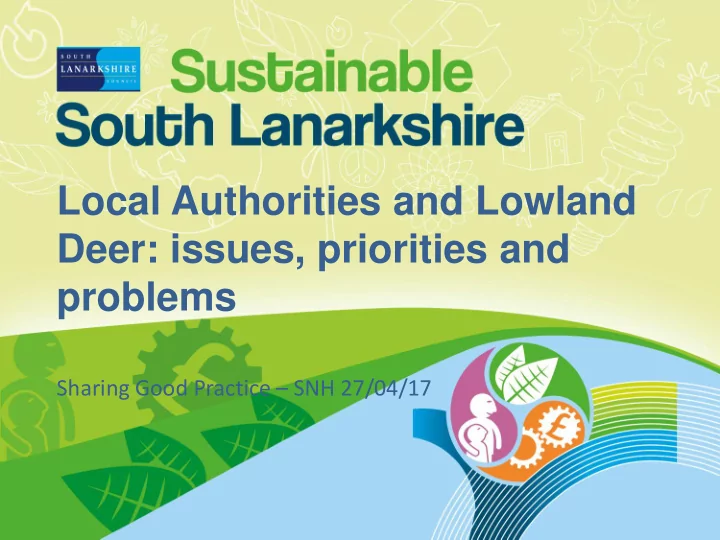

Local Authorities and Lowland Deer: issues, priorities and problems Sharing Good Practice – SNH 27/04/17
ECCLR Committee findings on lowland deer management • There should be: • better group structures and improved collaboration • more proactive approach by LAs and Agencies • Better supply chain for venison processing & marketing • Robust data on numbers, densities, and impacts • Concerned about: • variation in levels of Local Authority engagement • “encouragement” based approach, in terms of LA resource prioritisation – more “statutory rigour” needed? • DMGs and their representation through LDNS
South Lanarkshire Approach • Essentially, not much of one! • In common with many LAs, South Lanarkshire Council has no formal policy on managing deer. • However: • we do recognise the issues • we have an active local deer group with whom we engage • we are working to develop improved understanding of deer issues through our Biodiversity Implementation Plan and Open Space Strategy
What do we know? • Roe are widespread throughout South Lanarkshire • Various control regimes in rural / peri-urban areas • Most available, urban territories probably occupied • C. 20 DVCs on M74 each year (Transport Scotland) • Anecdotal and visual evidence of recent poaching • Evidence of significant browsing impact in some urban woodlands and protected sites • Most people seem to view urban roe as positive evidence of an “improving environment.”
What do we not know? • Next to no formal data on population or distribution • No consistent data on DVCs away from Trunk Roads • No consistent data on habitat impacts • No consistent data on crime & welfare incidents • Little solid information on roe population dynamics in urban settings In short: Little evidence that there is actually a problem (though there may well be one!)
Issues for Local Authorities • Policy prioritisation: LA and partners (e.g Police) • Resources: human and financial • Decision making: legislation – clarity and defensibility • Decision making: sensitivity of urban deer control • Decision making: risk management • Lack of supportive, empirical evidence • Lack of in-house expertise • Methodology - how do we actually manage urban deer effectively, humanely and sustainably?
Issues - Ecology • Roe Populations hard to estimate • Woodland dynamics and management histories are complex and it is often hard to isolate impacts of deer from other factors • Red and roe deer differ greatly in ecology and behaviour and require different policies and prescriptions. This must inform the concept of a “deer management system for Scotland.” • The impact of urban habitat connectivity on roe population dynamics and dispersal needs to be better understood.
Nocturnal count in Feb 2013 indicated about 47 roe occupying South Lanarkshire side of M74 corridor in Hamilton (c.165 ha) • 20 DVCs per annum • Poaching now increasing • Woodland in poor condition
Possible Ways Forward • Formalise LA engagement with and membership of DMG • Develop LA level reporting system for DRIs: Roads & Transportation; Cleansing; Environmental Protection; Police; SSPCA • Improve collation of Wildlife Crime incident reporting across LA, Police, SSPCA, etc. • Recognised Habitat Impact assessment methods (challenging) • Formalise Deer Management issues through inclusion in biodiversity plans and open space strategies, etc. • Planning and Land management: improve habitat connectivity and green corridors
Recommend
More recommend